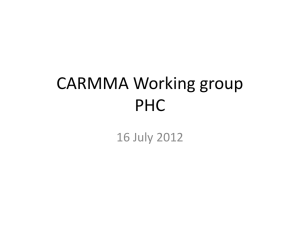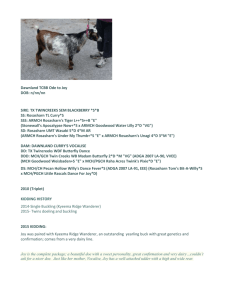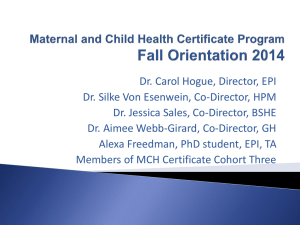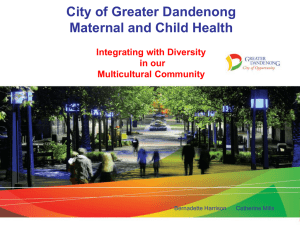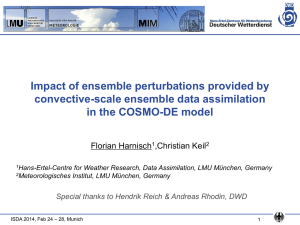KENDA_ARPASIMC-MCH_cooperation
advertisement
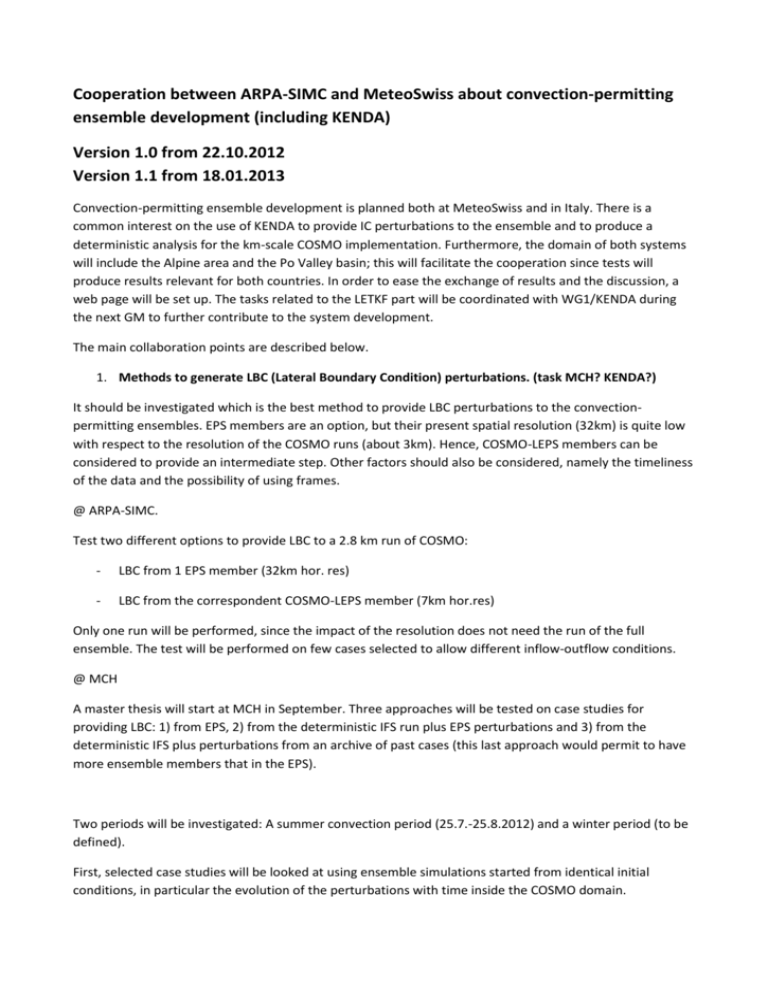
Cooperation between ARPA-SIMC and MeteoSwiss about convection-permitting ensemble development (including KENDA) Version 1.0 from 22.10.2012 Version 1.1 from 18.01.2013 Convection-permitting ensemble development is planned both at MeteoSwiss and in Italy. There is a common interest on the use of KENDA to provide IC perturbations to the ensemble and to produce a deterministic analysis for the km-scale COSMO implementation. Furthermore, the domain of both systems will include the Alpine area and the Po Valley basin; this will facilitate the cooperation since tests will produce results relevant for both countries. In order to ease the exchange of results and the discussion, a web page will be set up. The tasks related to the LETKF part will be coordinated with WG1/KENDA during the next GM to further contribute to the system development. The main collaboration points are described below. 1. Methods to generate LBC (Lateral Boundary Condition) perturbations. (task MCH? KENDA?) It should be investigated which is the best method to provide LBC perturbations to the convectionpermitting ensembles. EPS members are an option, but their present spatial resolution (32km) is quite low with respect to the resolution of the COSMO runs (about 3km). Hence, COSMO-LEPS members can be considered to provide an intermediate step. Other factors should also be considered, namely the timeliness of the data and the possibility of using frames. @ ARPA-SIMC. Test two different options to provide LBC to a 2.8 km run of COSMO: - LBC from 1 EPS member (32km hor. res) - LBC from the correspondent COSMO-LEPS member (7km hor.res) Only one run will be performed, since the impact of the resolution does not need the run of the full ensemble. The test will be performed on few cases selected to allow different inflow-outflow conditions. @ MCH A master thesis will start at MCH in September. Three approaches will be tested on case studies for providing LBC: 1) from EPS, 2) from the deterministic IFS run plus EPS perturbations and 3) from the deterministic IFS plus perturbations from an archive of past cases (this last approach would permit to have more ensemble members that in the EPS). Two periods will be investigated: A summer convection period (25.7.-25.8.2012) and a winter period (to be defined). First, selected case studies will be looked at using ensemble simulations started from identical initial conditions, in particular the evolution of the perturbations with time inside the COSMO domain. 2. Idealised cases with KENDA and tools development (task 1.2 MCH – task 3.4 KENDA) Before testing KENDA in a realistic situation, idealized cases will be generated, to understand how the system works. From an idealized model run, synthetic observations are generated, which can be in turn assimilated by KENDA. This requires the development of some new tools for putting synthetic or model-derived observations in the cdfin file. The development of this tools will be proposed as part of the KENDA tasks (to be discussed at the GM). @ MeteoSwiss 1) Horizontal homogenous case In this very simple setup, the temperature profile of an idealized atmosphere will be changed through artificially generated TEMP observations from a nature run. As nature run, a stably stratified, horizontally homogenous atmosphere at rest will be chosen. The assimilation simulations will start from a similar atmosphere with a slightly different temperature profile and will gradually be adapted to that of the nature simulation. 2) Alpine mountain circulation In this semi-idealized experiment, we will simulate the daily cycle of the mountain-plain flow on a sunny day (“Alpine pumping”) using the real Alpine topography on the target COSMO domain. During the day, a plain-mountain flow will be induced through differential heating of the mountain and the plain areas, which generates a pressure gradient and subsequent plain-mountain winds. During the night, a mountain-plain flow results from the opposite mechanism as during the day. The nature run will be produced using the best possible model using state-of-the –art physics and ar high resolution. Artificial observations of any kind can be extracted from this simulation using tools for generating cdfin NetCDF observation files from feedobs files (to be developed). The assimilation simulations will use a degraded model (either physical parameterisations, or resolution or both). A means for perturbing the ensemble members will need to be chosen (radiation parameterization?). This setup will also be suited for the testing of the deterministic analysis at a higher resolution. @ ARPA-SIMC 3) Temperature inversion in the Po Valley The nature run is perfomed by running the model without DA, producing synthetic TEMP for inversion. Then a second run is done by assimilating the synthetic TEMP with KENDA, with LW and SW radiation switched off in the model. 3. Ensemble size (task MCH? – task KENDA?) The impact of the ensemble size on the assimilation will be tested. This will be studied also in dependence of the other settings (adaptive rho, adaptive R,…) and observation density and type. 4. IC for deterministic analysis (task MCH? – task 3.5 KENDA) The use of KENDA to produce a very high resolution analysis for the deterministic COSMO implementation will be tested. Some open issues to be evaluated are: difference between the ensemble mean and the deterministic analysis run, spin-up effects, suitability of the analysis for a RUC system. It will also be studied how to improve the analysis accuracy by applying methodologies which permit to make better use of high-resolution data (e.g. radar), like “running in place” (Kalnay …).??? 5. Further development of the diagnostic tools (task 1.6 MCH – task 2.6 KENDA) After the GM it will be planned if some further work can be done, depending on what has been already achieved. n. Task 1 2 3 LBC perturbations Idealised cases Ensemble size Start End ARPA-SIMC 10 2012 06 2013 MCH 10 2012 06 2013 ARPA-SIMC 09 2012 03 2013 MCH 11 2012 03 2014 ARPA-SIMC 01 2013 12 2013 ARPA-SIMC 09 2013 09.2014 MCH 01 2013 06 2013 ARPA-SIMC 09 2012 09 2014 MCH 09 2012 09 2014 MCH 4 5 IC for deterministic analysis Diagnostic tools
